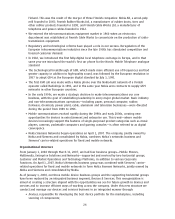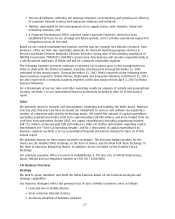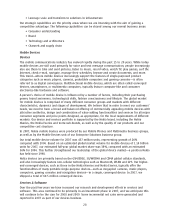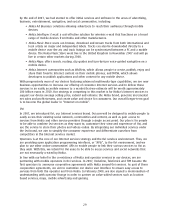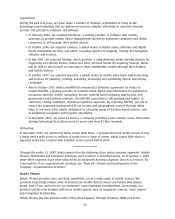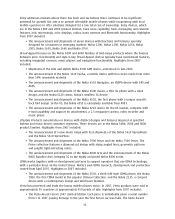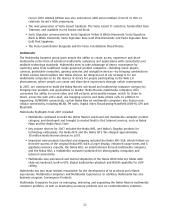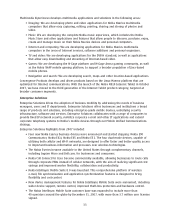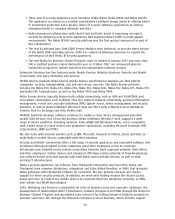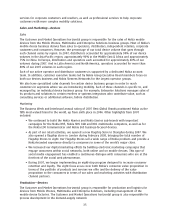Nokia 2007 Annual Report Download - page 37
Download and view the complete annual report
Please find page 37 of the 2007 Nokia annual report below. You can navigate through the pages in the report by either clicking on the pages listed below, or by using the keyword search tool below to find specific information within the annual report.Nokia operated ten manufacturing facilities in nine countries around the world as of December 31,
2007, for the production of mobile devices. Our Mexican and Brazilian plants primarily supply the
North and South American markets; our three European plants, located in Finland, Germany and
Hungary, principally supply Europe and the Middle East & Africa; and our two plants in China, our
plant in India and our plant in South Korea principally supply China and the AsiaPacific market. In
addition, we have a manufacturing plant in the United Kingdom serving Vertu.
Each of our plants employs stateoftheart technology and is highly automated. During 2007, we
made a significant capital investment in order to increase our production capacity, including opening
a plant in Chennai, India. In March 2007, we announced plans to set up a new mobile device
manufacturing plant in Romania, where production started in February 2008.
We continually assess the efficiency and competitiveness of our manufacturing facilities. As a result, in
January 2008, we announced plans to discontinue the production of mobile devices in Germany and
to close our Bochum site there by mid2008. We plan to move the production from the Bochum site
to our other, more costcompetitive sites in Europe.
In July 2007, our Operations & Logistics organization introduced a new operational mode, moving
from a model based around three time zones to a model made up of four global units. This new
operational mode is aimed at strengthening customer logistics and further improving the economies
of scale in our operations. We believe that it positions us even better to respond rapidly to the needs
of different geographic markets and to take advantage of the flexibility of our global manufacturing
network.
Our mobile device manufacturing and logistics—which we consider to be a core competence and
competitive advantage—are complex, require advanced and costly equipment and involve outsourcing
to third parties. During 2007, outsourcing covered approximately 20% of our manufacturing volume
of mobile device engines, which include the hardware and software that enable the basic operation
of a mobile device.
In line with industry practice, we source our components for our mobile devices from a global
network of suppliers. These components include electronic components, such as chipsets, integrated
circuits, microprocessors, memory devices, cameras, displays, batteries and chargers, and mechanical
components, such as covers, connectors, key mats and antennas. Our products also incorporate
software provided by third parties. We and our contract manufacturers assemble components and
activate devices with our own and thirdparty software. Final assembly typically takes place only for
firm customer orders.
Certain of the components we source may experience some price volatility from time to time.
Management believes that our business relationships with our suppliers are stable, and they typically
involve a high degree of cooperation in research and development, product design and
manufacturing. See “Item 3.D Risk Factors—We depend on a limited number of suppliers for the
timely delivery of sufficient amounts of fully functional components and subassemblies and for their
compliance with our supplier requirements, such as our and our customers’ product quality, safety,
security and other standards. Their failure to do so could materially adversely affect our ability to
deliver our products, services and solutions successfully and on time.”
Overall, we aim to manage our inventories to ensure that production meets demand for our products,
while minimizing inventorycarrying costs. The inventory level we maintain is a function of a number
of factors, including estimates of demand for each product category, product price levels, the
availability of raw materials, supplychain integration with suppliers and the rate of technological
change. From time to time, our inventory levels may differ from actual requirements. See “Item 3.D
Risk Factors—Our sales and results of operations could be materially adversely affected if we fail to
efficiently manage our manufacturing and logistics without interruption, or fail to ensure that our
products, services and solutions meet our and our customers’ quality, safety, security and other
requirements and are delivered on time and in sufficient volumes.”
36


